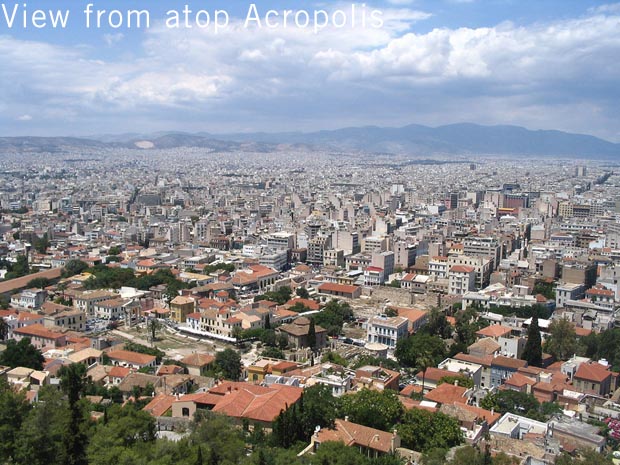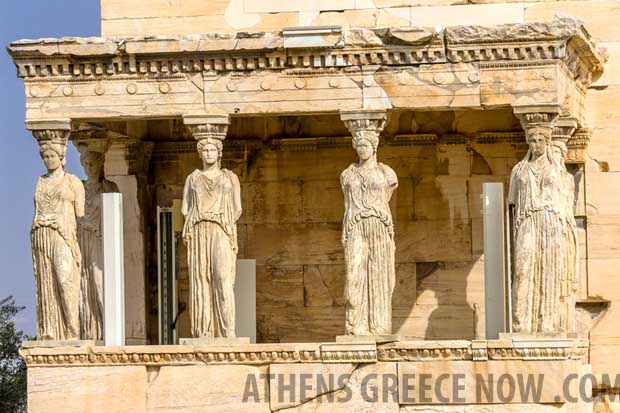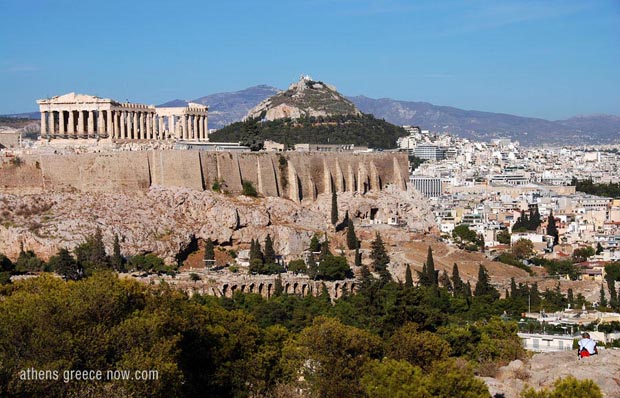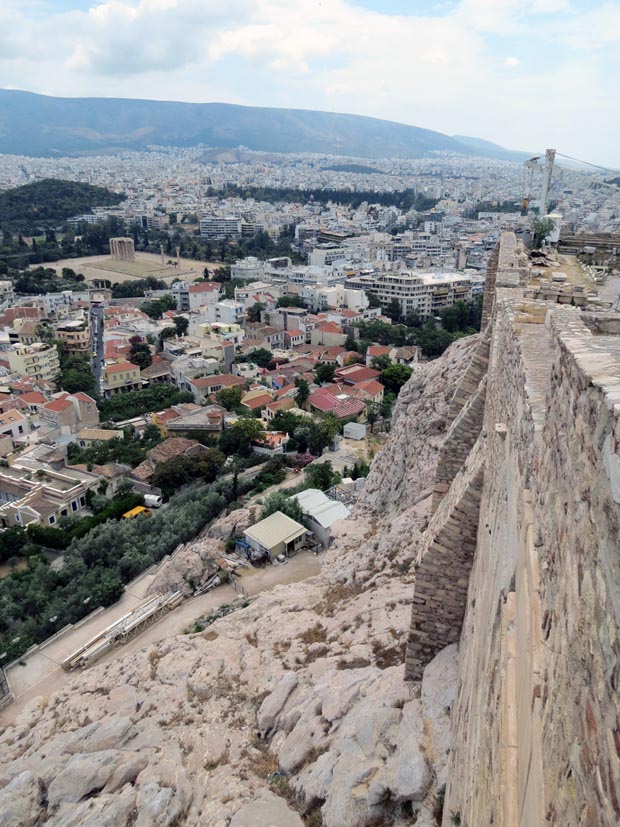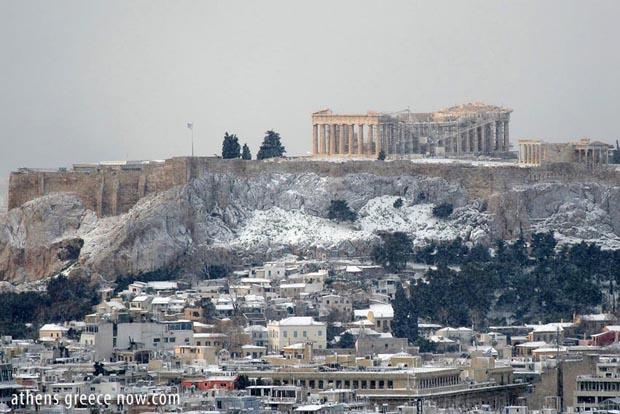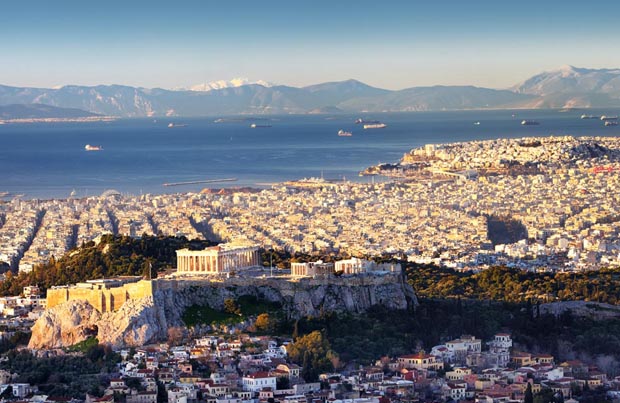The Acropolis in Athens, Greece
Ακρόπολη
Considered the preeminent site of ancient structures of the Western world, the Acropolis in Athens has stood the ravages of time for millennia
Though the Acropolis is estimated to have been used as a habitation by people since about 5,000 BC, the more recent construction of the most notable building, the present-day Parthenon, began in 447 BC. It was built during the Classical period of Ancient Greece from the leadership of the Athenian statesman Pericles and the artist Phidias. The Parthenon was completed 11 years later in 438 BC, with the sculptures finished 6 years later in 432 BC.
In later history, the Acropolis served as a religious ritual center, fortress, harem, church, capitol and is possibly the tourist-stop supreme. It is a constant touchstone used for histories of Western Civilization, where it will often be enthusiastically called 'the zenith of classical civilization achievement'.
The Acropolis mount rises 156 meters (512 feet) above sea level (for comparison, nearby Mount Lycabettus is 908 feet above sea level).
About the Acropolis Museum
Photo Gallery of the Acropolis
Map of the Acropolis
View of Athens from the Acropolis looking northward - on the left in the distance is the mountain called Mount Egaleo, sometimes spelled Aigaleo. In Greek αιγάλεω. In the further distance is the mountains Parnitha, also spelled as Parnetha. In Greek Πάρνηθα.
Seeing the Acropolis
The Acropolis is easily viewable from just about any location in Athens and the surrounding area, including the port of Piraeus. Likewise, from atop the Acropolis, one may see nearly all of Athens and out to the Saronic Gulf.
Brief History of the Acropolis, Athens, Greece
How the Acropolis / Parthenon was damaged
While being used as an armory by Turkish soldiers amid battle against the Venetian army during the war between the Ottoman Empire and the Republic of Venice in 1687, explosives stored in the building were accidentally set off when an overhead exploding cannon shell ignited the stockpile. The Parthenon roof, which had managed to stay in structurally safe repair since 438 BC, blew to pieces. Except the west wall, the interior walls were wrecked, with only the eastern pediment surviving more or less in tact. The Venetian general Francesco Morosini then attempted to remove horse and chariot sculptures along the west pediment, but these fell to the ground and smashed into pieces.
Additional damage to the Acropolis
A violent thunderstorm in 1645 set off stored gunpowder with a lightning strike. In 1827, Turkish artillery hit the Erechtheion during the Greek War of Independence, wrecking some of the Caryatid statuary. An earthquake in 1894 caused further destruction.
Parthenon vs Hekatompedon
The central structure on the Acropolis is the large, ancient temple commonly referred to as The Parthenon (translation: "house of virgins"). Historical evidence suggests that a nearby structure, the Erechtheion, is in fact the structure called 'the Parthenon' in ancient texts, and the larger, central building that was dedicated to the cult of Athena is the "Hekatompedon" (translation: "hundred-foot temple"). (This information is based on the work of Dr van Rookhuijzen from Utrecht University, published in American Journal of Archaeology and the National Geographic Magazine, Dutch edition, 2019)
Caryatids at the Erechtheion on the Acropolis
The Acropolis with Lycabettus Hill in background, Athens Greece
Removal of pieces from the Acropolis
The "Elgin Marbles" are the statuary and other pieces removed from the Acropolis in 1781 by Lord Elgin through an arrangement with the occupying Ottoman force. These pieces have been a source of contention for many decades as Greece has urged the British Museum in London to return the objects.
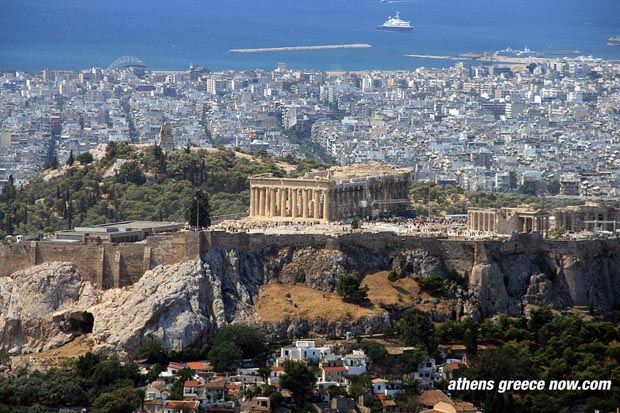
Piraeus in distance, overlooking the Acropolis mount
Costs for building the Parthenon
"The Parthenon, the Propylaea , the temple miscalled the Theseion overlooking the Agora, friezed with sculptures in Parian marble (still in situ) - - how did Periclean Athens afford such buildings? We read that the solid gold of the gown of Athena Parthenos made the cost of this statue 1,000 talents. A talent was equivalent to roughly $6,000, so this Phidias statue alone cost $6,000,000 [in 2012 the cost equivalent would be $1.4 trillion]; and then the Parthenon building 700 talents ($4,200,000). Altogether, Athens spent some $57,600,000 on edifices, sculpture and war-painting during the Periclean years."
From page 18, Greece: The Unclouded Eye, by Colin Simpson, Published by Wm. Morrow & Co., 1968. Simpson's costs are based on the 1939 book The Life of Greece, Simon and Schuster.
Acropolis wall
Visiting the Acropolis
"After seeing the monuments and visiting the museum, one should pause to take in the view of the city below. The Acropolis is high enough so that one can clearly see all that remains of ancient Athens and yet it is low enough so that one can feel the pulse of the modern city. On a field below the northwestern edge of the 'Sacred Rock' lies the agora, the center of ancient Athens, where Socrates strolled and Saint Paul preached to crowds assembled in the marketplace.
Besides the many ruins, the agora is the site of the Stoa of Attalus, which was completely rebuilt by American archaeologists in the Pentelic marble of the original. It now serves as a museum of the agora. To the west , on higher ground, is the Temple of Hephaestus, better known as the Theseion because it was long mistaken for a temple dedicated to the legendary king of Athens. The Theseion is the best-preserved Doric temple in Greece, and is a half brother to the Parthenon because of its beauty and harmony."
Page 150, Hellas: A Portrait of Greece, by Nicholas Gage, published by Villard Books, 1971, 1986
The Acropolis in the Greek Language
In the Greek language, "Acropolis" is written as "Ακρόπολη."
The parts of the word are::
- Ακρό (akro) means "highest" or "extreme."
- πολη (poli) means "city" or "town."
Therefore, "Ακρόπολη" (Acropolis) can be translated as "the highest or extreme point of the city." There are a number of "acropolises" in the world, but the most famous Acropolis is the one in Athens, Greece.
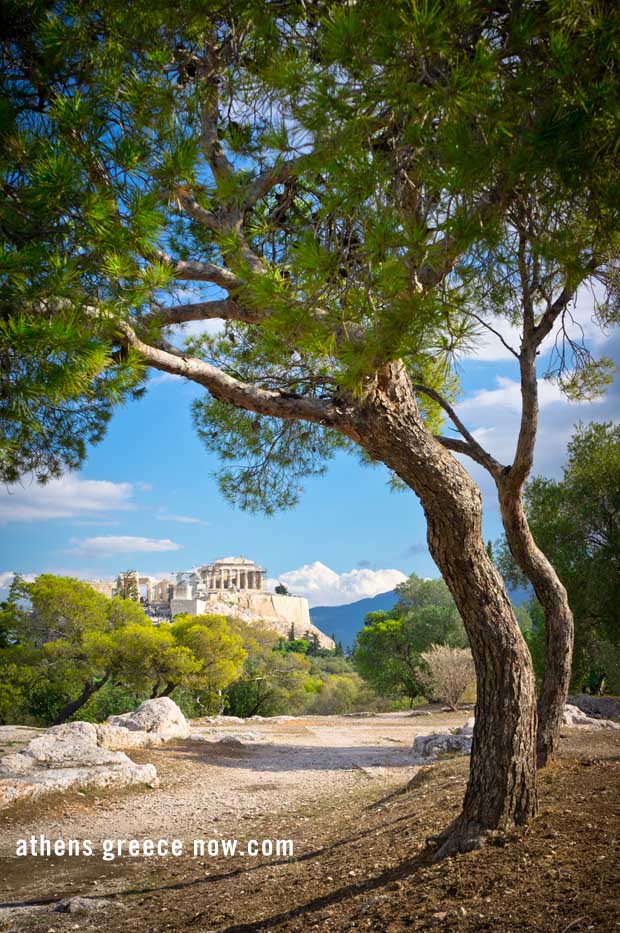
Next to the Acropolis, the ancient agora and the Stoa of Attalos
Containing many remains from the Acropolis the "Elgin Marbles"
About the Acropolis Museum
See also Archeology in Greece
Timeline
Important Dates in the history of the Acropolis
5000 BC
Approximate first indication of inhabitation of the Acropolis
1500-1200
The Mycenaean Period
1200-1000
The Dorian Invasion
1100-800
The Dark Ages
800-500
Archaic Period
800-600
Geometric Pottery
776
Origination of the Olympic Games
750
Homer's Iliad and Odyssey
635
Kylon history of Athens (he died 632)
630-480
The kouros statuary appear
630-475
Black figure vases appear
621
The law code of Drakon
594
Solon and the Athenian Constitution
566
The Panathenaic festivals reorganized
547-510
Tyranny of Peisistratid in Athens
530-500
Drama begins to evolve from strictly choral presentation
530
Red-figure pottery begins in Athens
514
Assassination of Hipparkhos (by Tyrannicides, Harmodius and Aristogeiton)
508
Cleisthenes Reforms the constitution
500-340
The "classic" period
499
Ionian cities revolt against Persia
490
Persian invasion of Greece
487
Reforms of the power of the arkhons
480-479
Second invasion of Greece by Persia
477
Formation of the Delian League led by Athens
447-433
Parthenon construction
437-432
Propylaia gateway constructed
431-404
Peloponnesian War
421-405
Erechtheion constructed on North side of Acropolis
404
The rule of "The Thirty Tyrants" a pro-Spartan oligarchy
338
Macedonian invasion
330-140
Hellenistic Age
322
The Lamian War and end of democracy in Athens
146
Roman invasion
86
Roman General Sulla sacks Athens (and Piraeus)
50
Apostle Paul in Athens
120-135
Roman Emperor Hadrian invests heavily in Athens (Hadrian ruled Rome 117 to 138) and sponsors the rebuilding of the Parthenon
267
The Herulians, an East German tribal group also called Heruli and classified as 'Gothic', sack Athens. Excavations since 1931 have shown that the size of the assault and the damage was much greater than originally believed in older historical records, and indicates the size of the city was also larger than what was thought previously for that era.
435
Theodosius II, also called Theodosius the Younger, ruled the Eastern Roman Byzantine empire from 408 to 450 and married a Greek woman named Aelia Eudocia, aka Athenais, daughter of Greek scholar Leontios. She later sponsored the building of what is perhaps the very first Christian church in Athens, near the Hadrian Library. Theodosius, influenced by his older sister Pulcheria, converted to Christianity and subsequently outlawed pagan-faiths throughout Greece in 435. Pulcheria governed as regent prior to him, and ruled briefly after his death.
Snow on the Acropolis
Read more about the Acropolis and the Parthenon pediments, metopes and freize art, and how Lord Elgin moved many of the pieces to London, here.
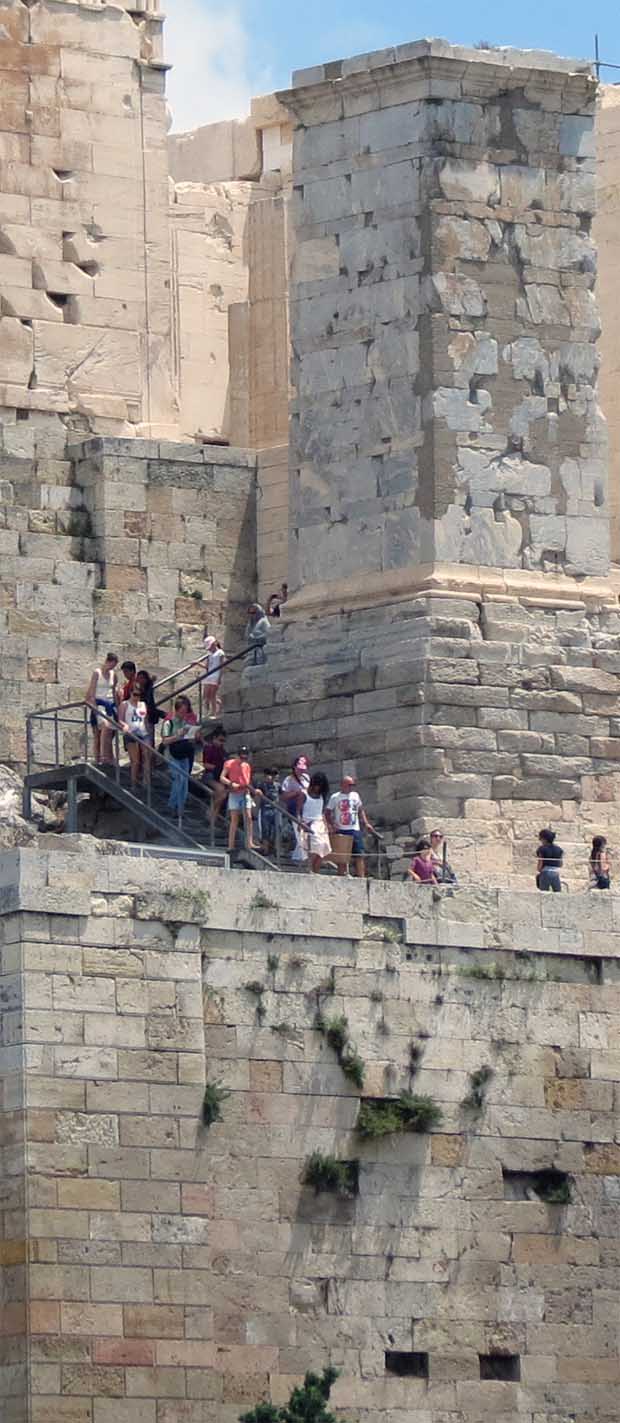
About the Acropolis Museum
View of Athens and the Saronic Gulf with Acropolis
The technical achievement of the Parthenon
November 22, 2022 Story at IN GR [Greek]
The Parthenon was built over an earlier temple of Athena, which was destroyed by the Persians during the Persian Wars. In more detail: It is believed that there was a brick temple on a stone foundation in the place where the Parthenon was built since the Geometric years (7th century BC). In the 6th century e.g. a ancient temple (Ur – Parthenon) was built and decorated with ancient sculptures that are exhibited in the Acropolis Museum (lions and Hercules with Triton)...

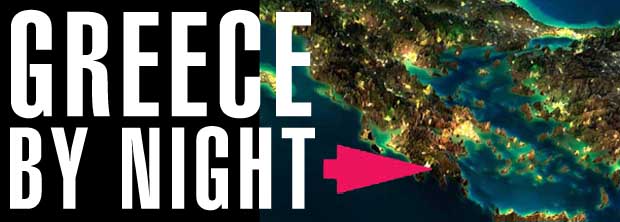


Greece's Golden Visa program
Advertisement: I am an Amazon affiliate
Original Page 2009 | Last Update December 20, 2022

